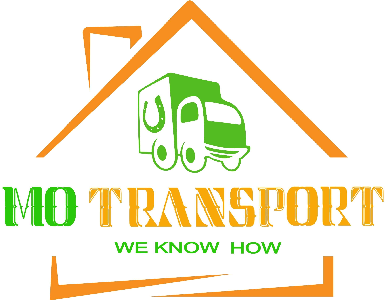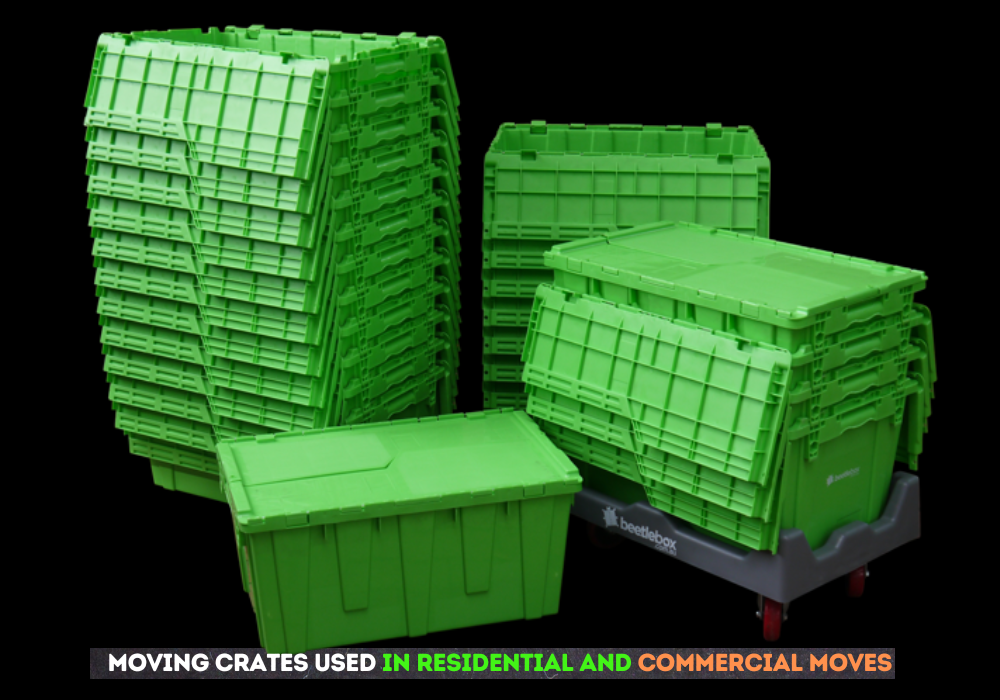A moving crate is a rigid, reusable container that protects and organizes items across packing, loading, transport, unloading, and setup. Built from wood or plastic, it standardizes dimensions, lids, and handles to control risk and speed handling. Wood crates carry heavy or fragile items such as machinery, appliances, and framed art through braced panels and mechanical fasteners that resist crush and vibration. Plastic crates handle high-volume contents such as files, laptops, peripherals, books, and kitchenware with interlocking lids and uniform footprints that accelerate stacking and dollying. In homes, this continuity produces safer handling, faster room sequencing, and cleaner unpacking with contents kept together. In offices, the same system delivers desk continuity, electronics protection, and labeled traceability for controlled handoffs during phased relocations. As operations progress, crates increase load density, reduce packing time, and improve stability on dollies, pallets, and trucks while cutting single-use cardboard waste and simplifying inventory control from origin to destination. Together, these properties define what crates are, where they apply, and why they enable efficient, protected residential and commercial moves.
What is a Crate?
A crate is a rigid, engineered container that encloses, stabilizes, and protects goods across packing, loading, transport, unloading, and setup. Wood crates use framed panels, cleats, and mechanical fasteners, so heavy or irregular loads remain braced against crush and vibration. Plastic crates use HDPE or PP shells with interlocking lids and uniform footprints, so teams stack, dolly, and palletize at consistent speeds. Handling features such as fork openings and molded grips align with equipment, and labeling systems maintain location control. Because structure governs load paths, a crate differs from a box; frames carry weight, standardized dimensions build stable stacks, and secure closures lock contents, which together deliver repeatable protection in homes and offices.
Who invented the crate and when was it invented?
The wooden crate has no single inventor because it developed through long carpentry and early industrial shipping. The modern plastic crate emerged in the 1950s and 1960s, as Australian dairy logistics refined the interlocking square form and United States manufacturers commercialized molded beverage crates. These parallel lines converged into the reusable standard used in retail, beverage distribution, and moving services.
What is the primary purpose of a crate?
The primary purpose of a crate is repeatable protection combined with controlled handling. Rigid walls and fasteners contain impact and limit vibration, so items arrive intact. Standardized footprints enable dense, stable stacking on dollies, pallets, and trucks, so space and time are used efficiently. Integrated grips and tight lids shorten load and unload cycles, while clear labeling preserves traceability from origin to destination. Taken together, these functions reduce packing time, minimize loss, and keep contents organized across residential and commercial moves.
Is crate different than moving crates?
No. A moving crate is the same crate used within a relocation workflow. The difference is context, not object. Wooden crates secure heavy or irregular items with framed panels, blocking, and fasteners. Plastic crates standardize high-volume packing with HDPE or PP shells, interlocking lids, and uniform footprints.
What are the main types of crates?
There are two main types of crates, wooden crates and plastic crates. Wooden crates are timber frames or paneled shells designed for heavy, fragile, or irregular loads; they offer high rigidity and custom bracing but add weight and build time. Plastic crates are HDPE or PP containers with hinged, interlocking lids and standardized footprints; they enable fast packing, nesting and stacking efficiency, easy sanitation, and long reuse life, but suit fixed size ranges and lighter loads.
1. Wooden crates
A wooden crate is a timber-framed, panelled container assembled with cleats, screws, and internal blocking for structural rigidity. It suits heavy, fragile, or irregular items such as machinery, appliances, framed art, and stone worktops because custom bracing prevents movement. The frame carries vertical and lateral loads and the panels disperse impact, so strength is high and durability is reliable through lifts, straps, and forklifts. Advantages include precise fit, strong edge protection, and effective shock control that lowers transit damage. Limitations include higher tare weight, longer build time, and moisture sensitivity without treatment, which complicate fast turnarounds and returns. Cost depends on size, timber grade, and build complexity; reuse is viable with inspection, minor repairs, and dry storage.
2. Plastic crates
A plastic crate is an HDPE or PP container with a molded body, reinforced rim, and hinged interlocking lids that stack when full and nest when empty. It suits high-volume packing of files, IT peripherals, books, kitchenware, and light inventory because standardized footprints align with dollies and pallets. Ribbed walls and consistent dimensions support stable columns, so strength is sufficient for everyday loads and handling is efficient room to room and vehicle to vehicle. Advantages include rapid pack-out, low handling effort, easy sanitation, and clear label panels for inventory control. Limitations include fixed size ranges and lower suitability for very heavy or oversized items, plus heat deformation risk under prolonged high temperatures. Cost depends on capacity, material grade, and whether units are rented or purchased; reuse spans many cycles with routine cleaning and hinge inspection.
Is a wooden crate the same as a wooden box?
No. A wooden crate is not a wooden box. A crate uses a load-bearing frame with posts, rails, and cleats that carry and brace the load. A box relies on panels only. Because the frame transfers forces, crates handle heavier or irregular items with blocking and strapping, while boxes suit lighter, regular contents that do not require internal bracing.
What are the main advantages of using crates for moving?
The main advantages of using crates for moving are:
- Protection: Rigid walls and secure lids limit impact, crush, and vibration damage, so items arrive intact.
- Speed: Standard sizes and handholds reduce packing, loading, and unloading time, so workflows remain predictable.
- Stack stability: Uniform footprints form dense, stable columns on dollies, pallets, and trucks, so space is used efficiently.
- Space efficiency: Consistent dimensions raise load density, so fewer trips are needed.
- Traceability: Label panels and barcodes maintain room mapping and counts, so inventory stays organized.
- Reusability: Durable materials support many cycles, so single-use waste decreases.
- Cleanliness: Smooth interiors protect finishes and allow quick sanitation, so items unpack cleanly.
- Security: Closed lids accept seals or ties, so tampering is deterred.
- Ergonomics: Balanced footprints and grips support safer manual handling, so strain decreases.
Together these advantages cut damage and time while preserving order from origin to destination.
Can plastic crates be used to pack household items?
Yes. Plastic crates pack household items effectively. HDPE or PP bodies with interlocking lids protect books, kitchenware, linens, toys, décor, and small appliances. Smooth walls prevent scuffing, and standardized footprints fit dollies and shelves. Very heavy or oversized items need wooden or specialty containers for adequate support.
What are the primary applications of crates in residential and commercial moves?
The primary applications of crates in residential and commercial moves are organized packing, protected transport, and controlled setup. In homes, crates group room contents such as books, cookware, pantry goods, clothing, toys, décor, and small electronics, which simplifies loading and short-term staging. In offices, crates move desk contents, files and archives, IT peripherals, sample stock, and smallwares during phased relocations, which preserves labeling continuity and keeps throughput consistent.
Can moving crates be used for house moves?
Yes, crates can be used for house moves because rigid, lidded containers keep each room’s items together, so packing and unloading follow the same sequence and fragile goods stay protected; use crates for books, kitchenware, clothing, toys, and small electronics, and use wooden or specialty packing for oversized or very heavy pieces.
Can moving crates be used for office moves?
Yes crates can be used for office moves because standardized footprints, interlocking lids, and label panels make desk-to-desk transfers fast, traceable, and orderly; use crates for files, stationery, peripherals, and smallware’s, and use server cases, copier skids, or equipment crates for heavy machinery.
Is it more practical to rent moving crates rather than buy them?
Yes renting crates is more practical than buying because most moves are short, so rental covers delivery, pickup, and sanitation while avoiding storage and maintenance; buying only makes sense for frequent internal moves, with break-even calculated as purchase price divided by weekly rental rate.
Where can I rent or purchase moving crates in Bristol?
You can rent or buy moving crates in Bristol through several reliable options. Amazon UK sells new plastic crates in various sizes and materials. Gumtree offers affordable used crates from local sellers, while Facebook Marketplace lists both private and business suppliers. If you prefer a managed service, you can rent directly from MO Transport. We handle delivery, pickup, and scheduling, so the crates arrive and return exactly when needed, ensuring a smoother moving process from start to finish.
Do moving companies in Bristol provide crates as part of their moving services?
Yes. Many moving companies in Bristol include crates in their moving packages. MO Transport provides high-quality crates along with all essential packing materials such as labels, seals, and wraps. This helps you pack faster and move safely without managing multiple suppliers. Because the crates are delivered, labeled, and collected by the same team handling your move, the entire process stays organized and efficient.
Which moving company in Bristol offers the best quality moving crates?
Several Bristol companies supply crates, but MO Transport is known for providing durable, professional-grade crates made from reinforced HDPE and PP materials. Each crate is inspected and sanitized before delivery. The design includes interlocking lids, smooth interiors, and labeling panels, which protect delicate items and maintain order during the move. This consistent quality and reliability make MO Transport’s crates one of the best options for both residential and office relocations.
How much does MO Transport charge for its crate rental service?
MO Transport includes crate use when customers purchase complete packing packages. For separate crate rentals, pricing depends on the crate type and rental duration. Standard crates typically cost £1.50–£3.00 per week, while specialized IT or archive crates may be slightly higher. A refundable deposit and a minimum one-week rental term may apply. When you share your move size and schedule, we provide an exact quote with transparent cost breakdowns before booking.
What is the process for renting crates from MO Transport in Bristol?
The process of renting crates from MO Transport is simple and follows clear steps:
- Request a quote: Share your move details—property size, dates, and item types—so we can calculate the correct number of crates.
- Confirm your order: Review the quote, agree on rental duration, and set delivery and pickup dates that fit your move.
- Receive your crates: We deliver clean, sturdy, and labeled crates with instructions for use.
- Use and return: Pack your items, complete the move, and we collect the empty crates from your new location.
- Finalize the process: We inspect and count the crates, refund any deposit, and send you a final confirmation.
Each step is coordinated to keep the move organized and stress-free, ensuring you receive clean, durable crates exactly when and where you need them.

